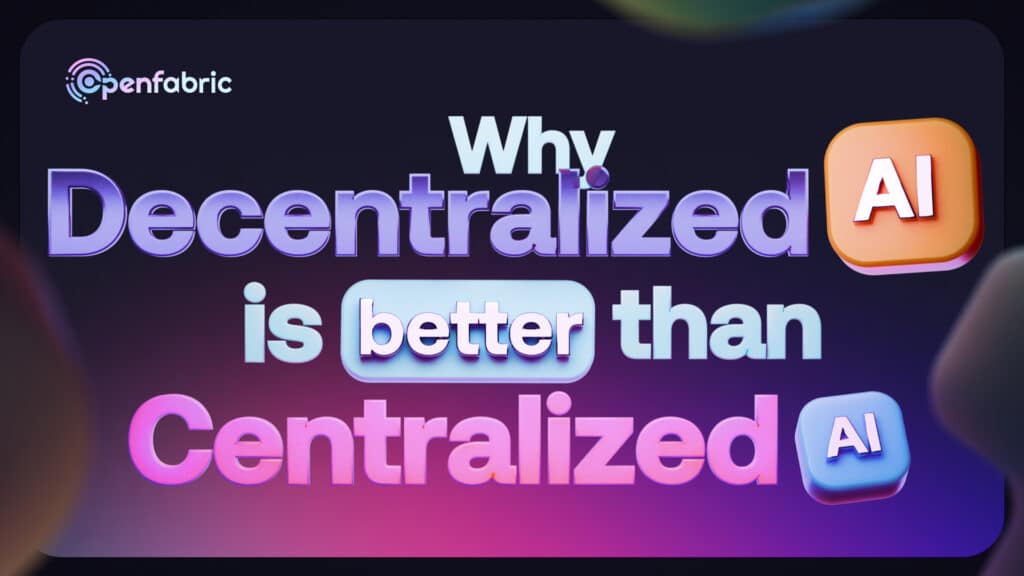
February 23, 2024 15 minutes read
Why Decentralized AI is better than Centralized AI

In today’s world of Artificial Intelligence, users often grapple with fundamental questions, seeking elusive answers in the complex landscape. Openfabric explores the profound advantages that come with the decentralization of AI, contrasting it with the limitations of centralized counterparts. Decentralized AI, in active practice, ensures a more democratic distribution of power, allowing diverse nodes to contribute and collaborate in real-time. This fosters innovation by tapping into a collective intelligence, promoting adaptability and resilience. The shift to decentralized models minimizes the risks associated with single points of failure, increasing reliability and security. Openfabric delves into the intricacies of this transformative approach. Bringing to limelight the dynamic potential that decentralized AI brings to the forefront of technological evolution.
Resilience and Redundancy
Resilience and redundancy stand as pillars of strength in the domain of decentralized AI, particularly when powered by Openfabric. The decentralized advantage becomes evident when we consider the robustness of the network in the face of potential disruptions.
In a decentralized AI system, Openfabric’s architecture ensures that the network remains less vulnerable to single points of failure. Imagine a scenario where one node encounters a failure or, worse, succumbs to compromise. The decentralized design allows other nodes to seamlessly take over, maintaining the continuity of operations without a hitch.
Comparatively, this resilience can be likened to a well-choreographed dance. One where every dancer is aware of their steps and can seamlessly adapt if one dancer stumbles. Openfabric’s decentralized approach ensures that the show goes on, undeterred by isolated setbacks. This level of resilience is crucial, especially in mission-critical applications where uninterrupted functionality is non-negotiable. Moreover, redundancy becomes a powerful ally in decentralized AI. Openfabric’s network is equipped with redundant nodes strategically placed throughout, creating a safety net that catches any unforeseen glitches. Redundancy ensures that the system can sustain itself even if certain nodes face challenges, offering a safety mechanism that guarantees continuous, uninterrupted service.
Consider this decentralized framework a resilient and redundant safety net that Openfabric meticulously weaves. It’s a network that anticipates challenges and responds with unwavering strength. The decentralized advantage, backed by Openfabric’s innovative approach, is not just a luxury; it’s a necessity for those who seek reliability and dependability in the constantly changing landscape of AI applications. The decentralized AI architecture propelled by Openfabric emerges as a beacon of reliability, ensuring that the system remains robust, resilient, and ready to face any challenges head-on. As the digital landscape continues to evolve, Openfabric’s decentralized approach stands as a testament to the future-proofing of AI systems.
Security
Data privacy and security stand as paramount concerns in today’s digital landscape, making it imperative to explore the advantages of decentralized AI, particularly through the lens of Openfabric. This advanced platform champions a user-focused approach, emphasizing the empowerment of individuals over their personal information. In the jurisdiction of data privacy, decentralized AI on Openfabric offers a distinct advantage by enabling local processing of data. This means that sensitive information doesn’t need to traverse across the internet to reach a centralized server. Instead, computations take place closer to the source, minimizing the risk of unauthorized access during data transmission. By adopting this approach, Openfabric aligns with its commitment to safeguarding user privacy. Thereby providing a contrast to traditional centralized AI models that necessitate the constant exchange of data with a central hub.
Moreover, the decentralized nature of Openfabric contributes to heightened security. Centralized AI systems often present a single point of failure, making them susceptible to cyber threats and attacks. In contrast, Openfabric’s decentralized architecture disperses the computational load across a network of nodes. This way, reducing vulnerability and enhancing resilience against potential security breaches. This fortifies the system against external threats and also ensures uninterrupted functionality, even in the face of localized disruptions. Openfabric’s commitment to user control is a driving force behind its decentralized approach.
Big On Privacy
Users can stay rest assured with the knowledge that their data remains under their jurisdiction, with no need to relinquish control to a central authority. This not only fosters trust but also positions Openfabric as a pioneer in championing a more secure and privacy-centric AI ecosystem.
For this reason, the shift towards decentralized AI on Openfabric marks a pivotal moment in the evolution of artificial intelligence. By prioritizing data privacy and security through local processing and a distributed architecture, Openfabric sets a new standard for user empowerment in the digital age. The days of compromising privacy for the sake of AI innovation are fading, and Openfabric is at the forefront of this revolution. By this, forging a path towards a more secure and user-centric AI landscape.
Efficient Resource Utilization
In the scope of artificial intelligence, the architecture that governs its operations plays a pivotal role in determining its effectiveness. Openfabric’s commitment to a decentralized approach stands as a testament to the advantages it brings to the table. One crucial aspect that distinguishes decentralized AI from its centralized counterpart is the efficient utilization of resources. Openfabric’s decentralized architecture facilitates the distribution of AI tasks across multiple nodes, a strategy that proves instrumental in optimizing resource utilization. Centralized systems may strain individual components, leading to bottlenecks and diminished performance. Openfabric’s decentralized approach ensures a more balanced and streamlined processing of tasks. This decentralized advantage directly translates to enhanced efficiency in overall system performance.
Imagine a scenario where a centralized AI system attempts to handle a multitude of tasks simultaneously. The strain on a single core or component can result in sluggish performance, delays, and potential system failures. Openfabric’s decentralized approach mitigates this risk by distributing tasks strategically, preventing any single node from bearing excessive burden. This not only safeguards against performance degradation but also allows for scalability as the system can seamlessly adapt to varying workloads. The optimization of resource utilization goes beyond immediate benefits. It establishes a foundation for sustained growth and adaptability in the rapidly evolving landscape of AI. Openfabric’s commitment to this decentralized model aligns with the ever-increasing demands for efficient and scalable AI solutions.
Openfabric’s decentralized architecture, with its focus on efficient resource utilization, stands as a beacon in the field of AI innovation. As industries continue to harness the power of artificial intelligence, the advantages offered by decentralized AI become increasingly apparent. Openfabric’s approach not only ensures optimal performance today but also lays the groundwork for the continued evolution and advancement of AI technologies tomorrow.
Community Driven Development
Openfabric’s commitment to decentralized AI brings to limelight, a turning point in the development landscape, particularly through its emphasis on community-driven development. This approach not only aligns with the ethos of inclusivity and collaboration but also presents distinct advantages over centralized AI models.
In a decentralized ecosystem, Openfabric taps into a diverse pool of contributors, fostering an environment where various expertise and perspectives converge to shape the trajectory of AI applications. This diversity is crucial as it ensures that the development process benefits from a multitude of insights, experiences, and problem-solving approaches. Centralized systems may be limited by the perspectives of a select few. Openfabric’s decentralized model taps into the collective intelligence of a global community.
This lies in its ability to leverage the strengths of individuals with different backgrounds and skill sets. Openfabric’s decentralized approach enables developers, researchers, and enthusiasts from various fields to contribute their unique knowledge. Thus creating a more comprehensive and robust foundation for AI advancements.
Furthermore, this model inherently promotes transparency and accountability. With contributions from a multitude of sources, the development process becomes more open and accessible. This transparency contrasts sharply with the opaque nature of many centralized AI systems, where the decision-making process is often confined to a select group. Openfabric’s commitment to community-driven development extends beyond mere collaboration; it empowers individuals to actively participate in shaping the future of AI. By embracing a decentralized approach, Openfabric is not just developing AI; it’s cultivating a community-driven revolution that places the power of innovation in the hands of many, not just a few. This decentralized paradigm ensures that the evolution of AI reflects the collective intelligence of a global community. Making it more adaptable, resilient, and aligned with the diverse needs of humanity.
Transparency and Accountability
Transparency and accountability stand out as key pillars in the argument for the superiority of decentralized AI, particularly under the stewardship of Openfabric. This innovative approach to artificial intelligence fosters a level of openness that centralized systems struggle to match. In decentralized systems, transparency is a natural byproduct of Openfabric’s commitment to openness. Users and developers alike can delve into the intricacies of algorithms, scrutinizing every line of code. This accessibility not only demystifies the decision-making process but also empowers individuals to validate and understand the inner workings of AI algorithms. This transparency acts as a catalyst for accountability, ensuring that AI decisions are made with precision and reliability.
Openfabric’s commitment to transparency is a game-changer. Traditional centralized systems often operate behind closed doors, making it challenging for users to comprehend the decision-making mechanisms. The opacity of these systems can lead to skepticism and mistrust, hindering the widespread adoption of AI technologies. In contrast, Openfabric’s decentralized approach is a breath of fresh air, offering a clear window into the decision-making process. Moreover, the transparency fostered by Openfabric is a cornerstone for building trust. Users can be confident that the AI algorithms are making decisions based on verifiable and well-understood principles. This trust is vital for the widespread acceptance and integration of AI technologies into various industries.
On Accountability
The accountability inherent in Openfabric’s decentralized AI is not just a theoretical concept; it’s a tangible reality. Users and developers can actively participate in the ongoing improvement and refinement of algorithms, ensuring that biases are addressed, and ethical considerations are prioritized. This collaborative approach to AI development sets a precedent for responsible and user-centric technology.
Openfabric’s decentralized AI framework excels in providing transparency and accountability, setting a new standard for the industry. As the AI landscape continues to evolve, this commitment to openness positions Openfabric as a leader, paving the way for a future where trust and accountability are non-negotiable elements of artificial intelligence.
Scalability
Scalability is a crucial aspect when it comes to the efficiency and performance of artificial intelligence (AI) systems. In the realm of decentralized AI, Openfabric’s architecture offers a distinct advantage in terms of scalability. In a decentralized framework, scalability is achieved effortlessly. Openfabric’s design allows for seamless integration of new nodes into the network, without burdening a central server. This streamlined scalability is a game-changer in the world of AI applications.
Imagine a centralized AI system as a single point of access, where all requests and data converge. As demands increase, the strain on this central server can result in delays and inefficiencies. On the other hand, Openfabric’s decentralized approach distributes the workload across multiple nodes. This means that as the demand for AI capabilities grows, new nodes can be effortlessly added to the network. Thereby ensuring optimal performance without overloading any single component. The significance of this scalability becomes apparent in various real-world scenarios. For instance, in a scenario where an AI application experiences a sudden surge in usage, a centralized system may struggle to cope. This will lead to degraded performance and user dissatisfaction. However, with Openfabric’s decentralized architecture, the system can adapt dynamically by incorporating additional nodes to handle the increased load, maintaining responsiveness and user satisfaction.
Intertwining Scalability with Innovation
Moreover, this scalability is not only about handling increased demand but also about fostering innovation. Openfabric’s decentralized AI provides a flexible infrastructure that can easily accommodate advancements in AI technology. Whether it’s incorporating new algorithms, expanding the dataset, or enhancing processing capabilities, the decentralized architecture ensures that the AI system can evolve seamlessly without the constraints of a centralized bottleneck.
Openfabric’s decentralized AI offers a scalable solution that is not only responsive to current demands but also adaptable to future advancements. This scalability is a fundamental advantage, ensuring that AI applications can grow and evolve without compromising performance or user experience. As the landscape of AI continues to expand, Openfabric stands as a pioneer. Providing a decentralized architecture that unlocks the true potential of scalable and efficient AI systems.
Reduced Latency
Openfabric’s approach to AI, distributed across multiple nodes, brings a notable reduction in latency compared to centralized processing. In simpler terms, this means faster response times, a crucial factor for applications that demand real-time or near-real-time interactions.
In addition to that, when AI processing is decentralized, tasks are divided among various nodes, allowing them to work concurrently. This parallel processing capability significantly cuts down the time it takes to execute commands and generate responses. Imagine a scenario where an AI-powered system needs to analyze vast datasets quickly to provide timely insights. Decentralized AI on Openfabric ensures that this process is expedited.
Consider a smart city’s traffic management system where real-time decisions are imperative. Decentralized AI on Openfabric enables the swift analysis of traffic patterns, rerouting vehicles dynamically to alleviate congestion. This not only enhances efficiency but also contributes to a smoother and more responsive urban environment.
Moreover, the reduced latency in decentralized AI on Openfabric is a game-changer for industries like finance, where split-second decisions can make a significant impact. Stock trading, for instance, relies heavily on quick data analysis and decision-making. Openfabric’s decentralized AI ensures that these processes happen with minimal delay, giving traders a competitive edge in fast-paced markets.
In essence, the decentralized architecture of AI on Openfabric is a catalyst for agility. Whether it’s optimizing traffic flow, facilitating quick financial transactions, or responding promptly in critical situations, the reduced latency achieved through decentralized AI is pivotal. Openfabric’s decentralized AI not only transforms the landscape of AI processing but also brings tangible benefits by minimizing latency. This approach ensures that AI applications deliver swift and efficient results. By this, making it a compelling choice for industries and scenarios that demand responsiveness and real-time decision-making.
Incentivizing Innovation
Openfabric’s commitment to a decentralized approach in the world of AI sparks a revolution in how innovation thrives. By sidestepping centralized gatekeepers, Openfabric empowers developers to unleash their creativity and experiment freely with AI models and applications. The decentralized advantage opens up a realm of possibilities, fostering a more dynamic and rapidly evolving ecosystem. In the traditional centralized AI landscape, developers often face cumbersome hurdles and bureaucratic red tape. Approval processes, stringent guidelines, and a lack of flexibility can stifle creativity, hindering the rapid development of groundbreaking solutions. Openfabric’s method eliminates these barriers, offering a refreshing environment where innovation is celebrated.
Imagine a world where developers can delve into new domains, pushing the boundaries of AI without the need for approval from centralized authorities. Openfabric’s approach allows for precisely that – a space where experimentation is the norm, leading to the creation of novel applications and cutting-edge models. Therefore, the beauty of Openfabric’s strategy lies in its simplicity. It removes unnecessary roadblocks, allowing innovators to focus on what they do best: creating. The power shifts to the hands of the developers. It provides them with the freedom to revolutionize AI without being tethered to rigid structures.
Furthermore, the decentralized advantage extends beyond just freedom; it fosters healthy competition. With a multitude of developers contributing to the ecosystem, a diverse array of ideas and perspectives emerges. This competitive environment incentivizes constant improvement and pushes the boundaries of what AI can achieve. Openfabric’s commitment to decentralization is not just a theoretical concept; it’s a practical game-changer for the AI landscape. By incentivizing innovation through a decentralized approach, Openfabric is not only evolving the industry but also paving the way for a future where AI evolves at an unprecedented pace. Furthermore, fueled by the creativity and ingenuity of a global community of developers.
Empowering Data Owners:
In the ever-evolving landscape of artificial intelligence, the battle between centralized and decentralized frameworks takes center stage. Openfabric, a trailblazer in the field, champions the cause of data ownership empowerment, highlighting the myriad advantages of a decentralized approach over its centralized counterpart. One of the key benefits of decentralized AI lies in its commitment to putting users in the driver’s seat when it comes to their data. Openfabric recognizes the significance of data ownership empowerment and aligns seamlessly with the ethos of decentralized AI. In this framework, individuals enjoy enhanced control over their personal information, a stark departure from the traditional model where centralized entities often hold the reins.
In a decentralized system, data is not concentrated in a single locus of control. Thereby mitigating the risk of unauthorized access and potential misuse. Openfabric’s approach ensures that users retain ownership and authority over their data, fostering a sense of trust and security. This shift in paradigm from centralization to decentralization represents a crucial step towards a more equitable and user-centric AI ecosystem. The decentralized advantage becomes even more apparent in scenarios where privacy concerns loom large. Openfabric’s commitment to safeguarding user data is reflected in its decentralized AI framework. This offers a privacy-first approach that resonates with individuals concerned about the unauthorized use of their personal information. This proactive stance not only enhances user confidence but also sets a precedent for responsible AI deployment.
Centered on Transparency
Furthermore, Openfabric’s emphasis on data ownership empowerment contributes to the overall transparency of the AI process. Users can track and understand how their data is utilized, fostering a culture of openness and accountability. This transparency not only builds trust but also encourages active participation from users. Thereby creating a collaborative environment where both individuals and AI systems coexist harmoniously.
Openfabric’s championing of data ownership empowerment within the decentralized AI framework marks a paradigm shift in the AI landscape. By placing control back into the hands of users, Openfabric not only enhances individual privacy but also fosters a more transparent, accountable, and user-centric AI ecosystem. The decentralized advantage, as exemplified by Openfabric, is not just a technological evolution but a testament to the commitment towards creating an AI future where empowerment and privacy go hand in hand.
Global Collaboration
Global collaboration stands at the forefront of the advantages offered by Openfabric’s decentralized AI approach. Unlike centralized systems, Openfabric’s structure breaks down geographical barriers, fostering a collaborative environment that spans the globe. This decentralized nature not only promotes inclusivity but also harnesses the collective intelligence of developers and organizations from diverse corners of the world. In a decentralized AI ecosystem, the traditional constraints of a centralized model are dismantled. Openfabric’s platform empowers developers to contribute and collaborate seamlessly, irrespective of their physical location. This global participation injects a rich tapestry of perspectives and experiences into AI projects, making them more comprehensive and reflective of varied societal needs.
The decentralized approach propels Openfabric beyond the limitations of a single entity steering AI development. Unlike centralized counterparts, where decision-making often lies within a confined circle, Openfabric’s structure ensures that the power to shape AI projects is distributed widely. This democratic distribution of influence not only encourages innovation but also guards against undue concentration of power, promoting a more equitable AI landscape.
Furthermore, global collaboration enhances the adaptability and applicability of AI solutions. Openfabric’s decentralized model taps into the collective wisdom of developers who understand the nuances of different regions and cultures. This ensures that AI applications are not one-size-fits-all but instead are finely tuned to address specific challenges faced by diverse communities.
Openfabric’s commitment to global collaboration is not just a philosophy but a practical realization of the potential that decentralized AI holds. The platform’s architecture provides the infrastructure for a worldwide community of developers and organizations to come together, transcending borders and working towards a shared vision of advancing AI for the benefit of humanity. In a world where interconnectedness is key, Openfabric’s decentralized approach emerges as the catalyst for a truly global and collaborative AI revolution.

